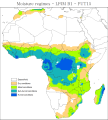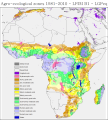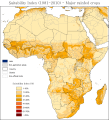agro-climatic
Type of resources
Available actions
Topics
Keywords
Contact for the resource
Provided by
Years
Formats
Representation types
Update frequencies
status
Resolution
-

Changes between the future (2021-2050) and the historical (1981-2010) moisture regimes have been identified. These conditions are derived from the agro-climatic outputs of the ClimAfrica project by using the LGP equivalent (LGPeq) and the Aridity Index over the LGPt season (AI LGPt). This analysis is done for the model LPJ-ml and two scenarios (B1 for CO2 on, and B2 for CO2 constant after 2000). This data set has been produced in the framework of the “Climate change predictions in Sub-Saharan Africa: impacts and adaptations (ClimAfrica)” project, Work Package 4 (WP4). More information on ClimAfrica project is provided in the Supplemental Information section of this metadata.
-

The moisture regimes are determined by the agro-climatic conditions. Two inputs from the ClimAfrica project are used to produce this data set: the LGP equivalent (LGPeq) and the Aridity Index over the LGPt season (AI LGPt). This analysis is done for the model LPJ-ml, for five 30-year periods. This data set has been produced in the framework of the “Climate change predictions in Sub-Saharan Africa: impacts and adaptations (ClimAfrica)” project, Work Package 4 (WP4). More information on ClimAfrica project is provided in the Supplemental Information section of this metadata.
-

The AEZ classification is a combination of soil and climatic conditions. The variable parameters are the agro-climatic conditions that determine the moisture regimes. These conditions are derived from the agro-climatic outputs of the ClimAfrica project by using the LGP equivalent (LGPeq) and the Aridity Index over the LGPt season (AI LGPt). This analysis is done for the model LPJ-ml and one scenario (B1 for CO2 on), for five 30-year periods. This data set has been produced in the framework of the “Climate change predictions in Sub-Saharan Africa: impacts and adaptations (ClimAfrica)” project, Work Package 4 (WP4). More information on ClimAfrica project is provided in the Supplemental Information section of this metadata.
-

The suitability analysis allowed identifying a suitability index combining the suitability weights (combination of soil and climate) of the twelve major crops. Changes between the historical (1981-2010) and the future period (2021-2050) have been identified. This dataset has been produced in the framework of the "Climate change predictions in Sub-Saharan Africa: impacts and adaptations (ClimAfrica)" project, Work Package 4 (WP4). More information on ClimAfrica project is provided in the Supplemental Information section of this metadata.
-

The suitability analysis allowed identifying a suitability index combining the suitability weights (combination of soil and climate) of the twelve major crops for the historical period (1981-2010). This data set has been produced in the framework of the “Climate change predictions in Sub-Saharan Africa: impacts and adaptations (ClimAfrica)” project, Work Package 4 (WP4). More information on ClimAfrica project is provided in the Supplemental Information section of this metadata.
-

The suitability analysis allowed identifying a suitability index combining the suitability weights (combination of soil and climate) of the twelve major crops for the future period (2021-2050). This data set has been produced in the framework of the “Climate change predictions in Sub-Saharan Africa: impacts and adaptations (ClimAfrica)” project, Work Package 4 (WP4). More information on ClimAfrica project is provided in the Supplemental Information section of this metadata.
 FAO Map Catalog
FAO Map Catalog